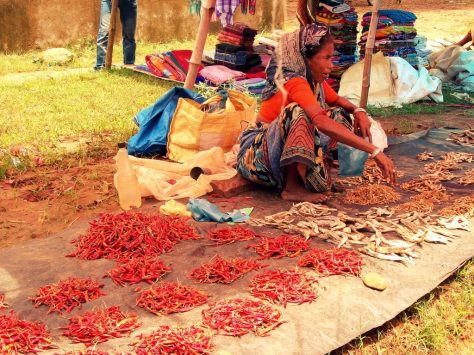Is Microfinance a boon or bane..? My learnings from the field
August 22, 2012
I always wondered how far microcredit actually helped alleviate the lives of the poor especially after the SKS Microfinance crisis in Andhra Pradesh. There has been a lot of criticism that this industry was full of profit motivated rather than socially focused players. So, I always wanted to understand what would make micro finance perform stronger socially.The reason I say my fellowship was rewarding is because I had all these questions answered through my eyes and ears in the process of being Kiva’s Eyes and Ears on field.
Two weeks back I was juggling between profile posting, field visits, group photos, and field staff training. Amidst this time crunch phase, a visit to the local weekly market came as liberation. It was so colorful and vibrant may be because 40% of the vendors were women selling vegetables, bangles, local snacks, cooking utensils etc…
The aromas(including of stinking dry fish), haggling noises and people around did not irritate me somehow.Seemed like a perfect recipe for a break. Every 2 shops that we passed by, the branch manager would introduce me to some woman telling me that she is their client and started/grew their business with a financial support from them.
It is when I met people like Lalitha and Bijaya Lakshmi that I started wondering about their livelihood in the absence of microfinance. Would they have had help from traditional banks?
Could Lalitha have started a vegetable business without the intervention of Mahashakti; one of Kiva’s Indian partners with a strong social focus…? Lalitha was selling vegetables in the market. She started selling vegetables with the help of a micro loan to supplement her husband’s income who works as a daily labor in the paddy fields. The additional income has actually helped them move from a mud house to a concrete house. In the photo she holds some drumsticks(moringa) which she saved from her merchandise to cook for her daughter who loves the curry.
As I walked through the stretch of canvas of colors and aromas , I met several other women who were happy to have received a loan and felt empowered through their business.
Or would Bijayalakshmi and her husband have been able to sustain their livelihood without financial support in the form of microcredit..? I went to meet her as we were going to post her loan on Kiva. She spends almost 10hrs a day making local snacks and her husband sells them the next day. They are both in their fifties and have no sons to take care of them in their old age as any other parent who has crossed 50s would have been in India. When I asked her about being on internet, she answered with her infectious smile and energy “I am happy to let people know how hard we are working. This may motivate others to work hard and create opportunities for themselves”. I had nothing to say but be amazed.
But all microfinance clients do not have a success story to share. If it were so, we would not have had those suicides in Andhra Pradesh and MFI industry in India would not be in such a crisis today. So, I thought to myself may be all of microfinance is not good or all of it is not bad. I was reminded of the “half glass” paradox.
Back in my room in the evening I was wondering how MFIs should evolve their model to not let the critics undervalue microfinance by half its potential. It finally dawns on me that MFIs should look for holistic solutions to poverty and provide innovative services by understanding the needs of the customers like any other industry and not just focus on micro credit.
I learnt from my interactions here that more than 40% of a household annual income is spent for health and it plays a major role in repaying the loan. So, health should be one major area of focus for the MFIs. Some of the MFIs in India like one of Kiva’s Indian partners Mahashakti have now started providing health based initiatives like micro insurance, credit support for safe drinking water, water and sanitation loans etc… As one of Mahashakti’s management staff puts it “Providing basic needs first and then lending builds a stronger bond and trust between the MFIs and the borrowers.” I think this trusted relation is essential for any MFI’s sustained impact and survival in their strive for the creation of economic independence.
These client focused initiatives are implemented only by 5% of all MFIs in India and need to be more wide spread. It is very encouraging to see this shift in the MFI model in India though and hope to see many more moving in this direction.It is good to see Kiva also increase its focus beyond traditional microfinance and work with such partners.
PREVIOUS ARTICLE
Photographer Pep Bonet captures the transformative power of microfinance, shares proceeds with Kiva →NEXT ARTICLE
Passport Series: Microfinance helps Sierra Leone heal wounds of the past →


















